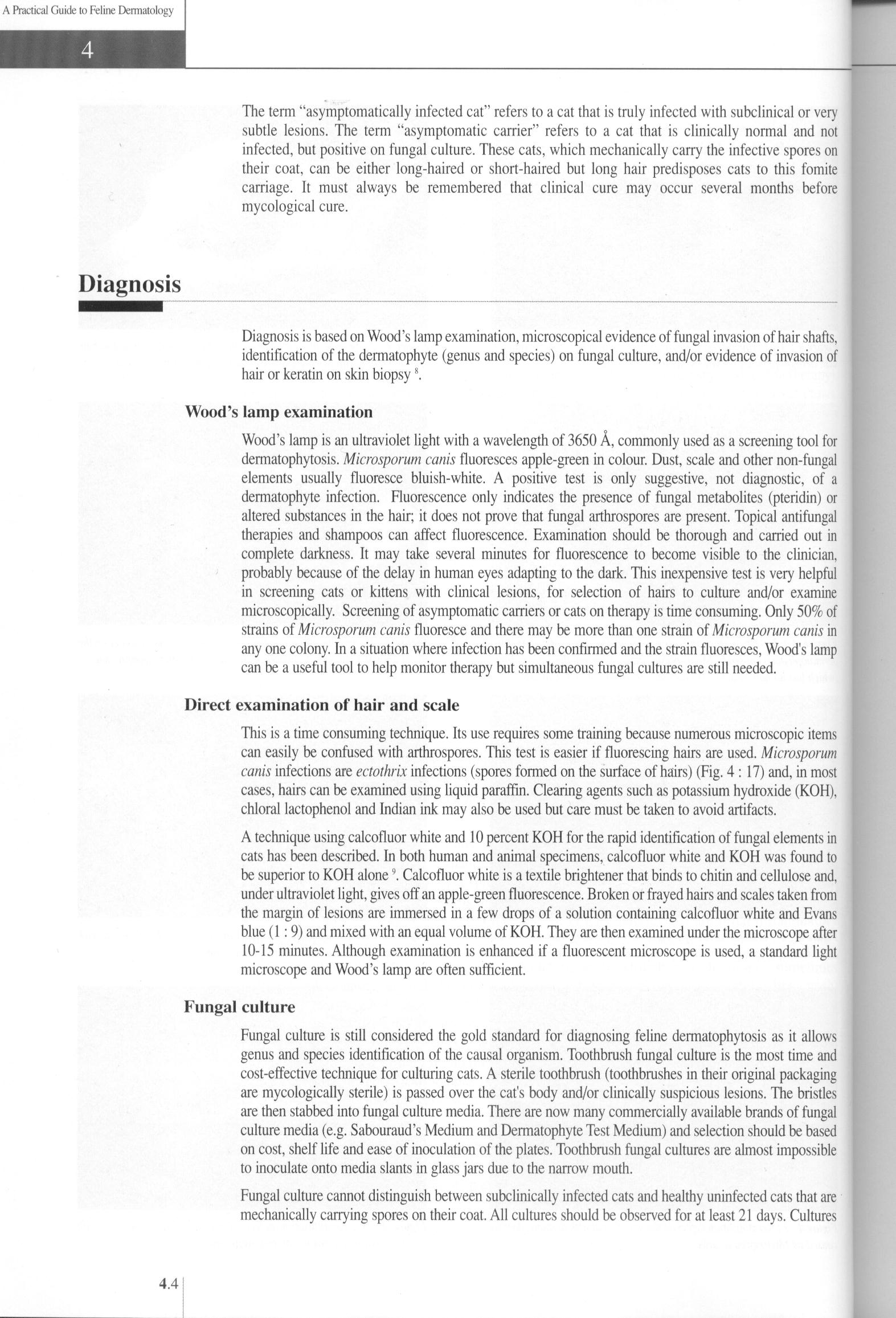44 (228)

4
A Practical Guide to Feline Dermatolog)'
The term “asymptomatically infected cat” refers to a cat that is truły infected with subclinical or very subtle lesions. The term “asymptomatic carrier” refers to a cat that is clinically normal and not infected, but positive on fungal culture. These cats, which mechanically carry the infective spores on their coat, can be either long-haired or short-haired but long hair predisposes cats to this fomite carriage. It must always be remembered that clinical cure may occur several months before mycological cure.
Diagnosis
Diagnosis is based on Wood’s lamp examination, microscopical evidence of fungal invasion of hair shafts, identification of the dermatophyte (genus and species) on fungal culture, and/or evidence of invasion of hair or keratin on skin biopsy8.
Wood’s lamp examination
Wood’s lamp is an ultraviolet light with a wavelength of 3650 A, commonly used as a screening tool for dermatophytosis. Microsporum canis fluoresces apple-green in colour. Dust, scalę and other non-fungal elements usually fluoresce bluish-white. A positive test is only suggestive, not diagnostic, of a dermatophyte infection. Fluorescence only indicates the presence of fungal metabolites (pteridin) or altered substances in the hair; it does not prove that fungal arthrospores are present. Topical antifungal therapies and shampoos can affect fluorescence. Examination should be thorough and carried out in complete darkness. It may take several minutes for fluorescence to become visible to the clinician, probably because of the delay in human eyes adapting to the dark. This inexpensive test is very helpful in screening cats or kittens with clinical lesions, for selection of hairs to culture and/or examine microscopically. Screening of asymptomatic carriers or cats on therapy is time consuming. Only 50% of strains of Microsporum canis fluoresce and there may be morę than one strain of Microsporum canis in any one colony. In a situation where infection has been confirmed and the strain fluoresces, Wood’s lamp can be a useful tool to help monitor therapy but simultaneous fungal cultures are still needed.
Direct examination of hair and scalę
This is a time consuming technique. Its use reąuires some training because numerous microscopic items can easily be confused with arthrospores. This test is easier if fluorescing hairs are used. Microsporum canis infections are ectothrix infections (spores formed on the surface of hairs) (Fig. 4:17) and, in most cases, hairs can be examined using liąuid paraffin. Clearing agents such as potassium hydroxide (KOH), chloral lactophenol and Indian ink may also be used but care must be taken to avoid artifacts.
A technique using calcofluor white and 10 percent KOH for the rapid identification of fungal elements in cats has been described. In both human and animal specimens, calcofluor white and KOH was found to be superior to KOH alone9. Calcofluor white is a textile brightener that binds to chitin and cellulose and, under ultraviolet light, gives off an apple-green fluorescence. Broken or frayed hairs and scales taken from the margin of lesions are immersed in a few drops of a solution containing calcofluor white and Evans blue (1:9) and mixed with an equal volume of KOH. They are then examined under the microscope after 10-15 minutes. Although examination is enhanced if a fluorescent microscope is used, a standard light microscope and Wood’s lamp are often sufficient.
Fungal culture
Fungal culture is still considered the gold standard for diagnosing feline dermatophytosis as it allows genus and species identification of the causal organism. Toothbrush fungal culture is the most time and cost-effective technique for culturing cats. A sterile toothbrush (toothbrushes in their original packaging are mycologically sterile) is passed over the cat’s body and/or clinically suspicious lesions. The bristles are then stabbed into fungal culture media. There are now many commercially available brands of fungal culture media (e.g. Sabouraud’s Medium and Dermatophyte Test Medium) and selection should be based on cost, shelf life and ease of inoculation of the plates. Toothbrush fungal cultures are almost impossible to inoculate onto media slants in glass jars due to the narrow mouth.
Fungal culture cannot distinguish between subclinically infected cats and healthy uninfected cats that are mechanically carrying spores on their coat. Ali cultures should be observed for at least 21 days. Cultures
4.4
Wyszukiwarka
Podobne podstrony:
58 (148) 5 A Practical Guide to Feline Dermatology severity of the illness. High titres are seen wit
69 (119) 6 A Practical Guide to Feline DermatologyDiagnosis The diagnosis is based on lesion distrib
28 (374) 2 A Practical Guide to Feline Dermatology Configuration of lesions Determining the configur
313 (14) A Practical Guide to Feline Dermatology The second phase consists of long-term control of t
82 (128) 8 A Practical Guide to Feline Dermatology considered important parasites. Cats in the Unite
42 (226) 4 A Practical Guide to Feline Dermatology Increased hydration and subsequent maceration of
54 (167) 5 A Practical Guide to Feline DermatologyClinical features The disease can present in three
35 (267) A Practical Guide to Feline Dermatology 1 3 Table 3:1: Identification of the principal
37 (248) 3 Practical Guide to Feline DermatologyDiagnosis The diagnosis is based on finding these 6
236 (22) Practical Guide to Feline Dermatology23 observed on the whole body. Nodular lesions primari
248 (22) 24 A Practical Guide to Feline DermatologyDiagnostic tests Given the incidence of dermatoph
65 (127) 6 A Practical Guide to Feline Dermatology Other topical antimicrobial agents, such as chlor
67 (125) 6 A Practical Guide to Feline DermatologyNocardiosisAetiopathogenesis Nocardiosis is a very
710 (2) 7 A Practical Guide to Feline DermatologyHerpesvirus infections Dermatological manifestation
74 (105) 7 A Practical Guide to Feline Dermatology ulcerated. Lesion distribution is multicentric bu
27 A Practical Guide to Feline Dermatology Perianal glands 1.7 Permethrin 3.12, 3.13 Persian 1.6,2.2
27 A Practical Guide to Feline Dermatology Stemphyllium spp. 5.1,7.8 Stereotypie behaviour 17.1,
272 (16) 27 A Practical Guide to Feline Dermatology Alternaria spp. 5.1,7.8 Aluminium hyroxide 15.6&
274 (18) 27 A Practical Guide to Feline Dermatology Colitis 11.2 Collagen 1.2,2.6,12.1,
więcej podobnych podstron